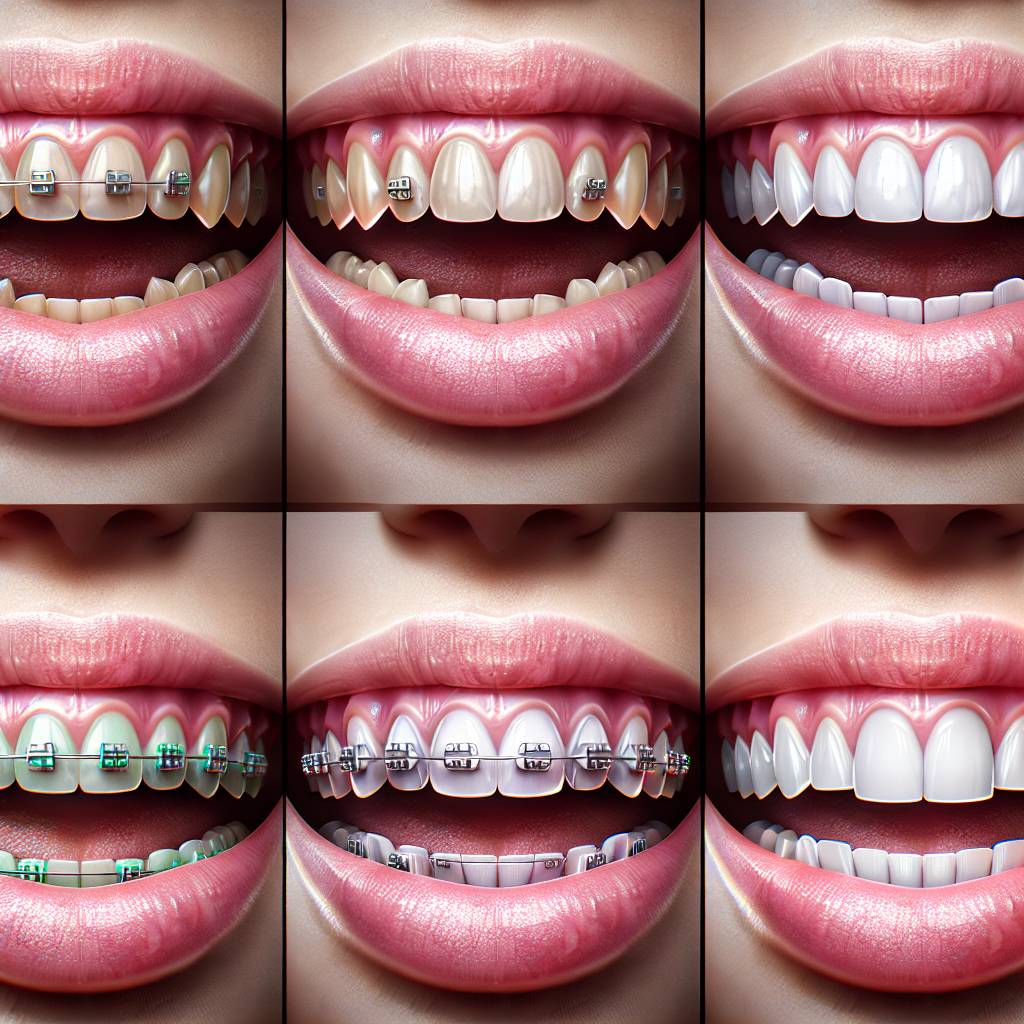Straightening teeth with braces or aligners can be a lengthy process, but the results are worth the wait. Depending on the severity of your misaligned teeth and the type of treatment used, it can take anywhere from three months to two years or more to achieve a perfectly straight smile. In this article, we will look at how long it takes to straighten teeth and what you can expect throughout your orthodontic treatment journey.The length of time it takes to straighten teeth depends on the severity of the misalignment. Generally, it can take anywhere from 6 months to 2 years to fully straighten teeth with braces. Invisalign treatments can take as little as 6 months, but may take up to 18 months depending on the complexity of the case.
Factors Influencing Teeth Straightening
The process of straightening teeth, also known as orthodontic treatment, is typically recommended to improve the appearance and health of the teeth. The factors that influence the straightening of teeth include the severity of misalignment, the age of the patient, and the type of orthodontic treatment chosen.
The severity of misalignment plays a major role in deciding if orthodontic treatment is needed and what type is best. If teeth are severely misaligned, more complex treatments such as braces or Invisalign may be necessary. If the misalignment is milder, simpler treatments such as retainers may be recommended.
Age can also be a factor when it comes to orthodontic treatment. Children between ages 7-11 are most likely to need orthodontic treatment because their jaws are still growing rapidly during this time. However, adults can also benefit from orthodontic treatment as long as they have healthy gums and bones that support their teeth.
The type of orthodontic treatment chosen will also affect how long it takes for teeth to be straightened. Traditional metal braces are often used to make major adjustments in a shorter amount of time while more discreet options like Invisalign may take longer but can provide more subtle results over time. The patient’s preferences and lifestyle should also be considered when choosing an orthodontic treatment plan.
What Are the Different Types of Teeth Straightening Treatments?
Teeth straightening treatments are designed to help align teeth and improve the overall aesthetics of a smile. There are a variety of different types of treatments designed to suit different needs, ranging from simple at-home treatments for mild cases, to more involved treatments from a professional. The most common types of teeth straightening treatments include traditional braces, Invisalign, and clear aligners.
Traditional Braces
Traditional braces use metal brackets that are bonded to the front-facing side of each tooth. A wire is then threaded through the brackets and tightened periodically throughout the treatment process in order to gradually shift teeth into place. Traditional braces can be used to correct mild to moderate misalignment issues and take about 12 months on average to complete.
Invisalign
Invisalign is an alternative form of orthodontic treatment that uses clear plastic aligners instead of metal brackets and wires. The plastic aligners are custom-made for each patient and are designed to be removable so that they can be taken out for eating and brushing. Invisalign is a great option for those with mild to moderate misalignment issues who want an invisible treatment option that won’t interfere with their daily activities. Treatment typically takes between 12 and 18 months on average.
Clear Aligners
Clear aligners are another popular orthodontic treatment option that uses clear plastic trays instead of brackets and wires like traditional braces or Invisalign. Clear aligners are worn over the teeth like trays and gradually shift them into place over time using gentle pressure. They’re also removable for eating, drinking, brushing, and flossing which makes them more comfortable than traditional braces or Invisalign. Clear aligners typically take between 12 and 18 months on average depending on the severity of misalignment issues being treated.
How Do Orthodontists Determine the Length of Treatment Needed?
Orthodontists use a variety of factors to determine the length of treatment needed for a patient. First, they take into account the patient’s age, as younger patients tend to respond better to orthodontic treatment than older patients. Secondly, they consider the severity of the misalignment or malocclusion and what type of treatment is necessary to correct it. Finally, they look at the patient’s compliance with their treatment plan; how well they follow instructions and attend regular check-ups or appointments will have an impact on how long it takes to complete their treatment.
In general, orthodontic treatments can range from six months to two years or longer. Mild cases may only require six months of treatment while more severe cases may require two years or more. The exact length of treatment will vary depending on the individual patient and their particular needs. Orthodontists may also recommend additional treatments such as Invisalign or retainers in order to maintain results after the main orthodontic treatment is completed.
The best way for a patient to get an accurate estimate of their expected treatment length is to meet with their orthodontist for a consultation and examination. During this appointment, the orthodontist will be able to review all relevant factors that can influence how long it takes for a patient’s teeth to be properly aligned and give them an estimate based on those factors.
It is important for patients to keep in mind that although an estimated length of time may be given, it is not always exact. As teeth move during orthodontic treatments, it can alter how long certain procedures take; however, good compliance with instructions should help minimize any unexpected delays in completion time.
How Does Age Impact the Time It Takes To Straighten Teeth?
Age is a major factor when it comes to the time needed to straighten teeth. Generally speaking, younger patients are able to achieve straighter teeth in a shorter timeframe compared to older patients. This is because younger patients have more malleable teeth and bones, which allows them to be reshaped more quickly and easily. Additionally, younger patients often have fewer existing dental issues which can impact the orthodontic treatment process.
On the other hand, older patients may require more time for their orthodontic treatment due to certain factors such as changes in bone density or existing dental issues that need addressing before straightening can begin. Patients with existing decay or gum disease will need these issues resolved before orthodontic treatment can begin, and this can add time to the process.
Age is certainly an important factor when it comes to how long it takes to straighten teeth, but it’s not the only one. The type of braces being used and the severity of misalignment will also play a role in determining how long it takes for teeth to be straightened. Additionally, patient compliance with instructions from their orthodontist is essential for successful treatment; if a patient does not follow through with wear times or keep up with regular appointments, this will add time onto their overall treatment timeline as well.
Overall, age can impact how long it takes to straighten teeth; however, many other factors can come into play as well. It’s important that all patients take all necessary steps towards successful orthodontic treatment in order for them to achieve straighter teeth in a timely manner.

What Are the Benefits of Straighter Teeth?
Straighter teeth offer a variety of benefits, both physical and psychological. From improved oral health to greater confidence, straighter teeth can have a significant impact on your life. Physically, straighter teeth are easier to clean and maintain, helping to reduce the risk of cavities and gum disease. Additionally, straight teeth function better than crooked or misaligned teeth, leading to improved chewing and speaking abilities. Psychologically, having straighter teeth can boost self-esteem and improve social interactions. With a beautiful smile, you may feel more confident in yourself and be less self-conscious about your appearance. Straighter teeth can also help improve the overall shape of your face by providing balance and symmetry. Ultimately, having straighter teeth can help you look and feel your best.
Common Side Effects of Teeth Straightening Treatments
Teeth straightening treatments, such as braces and aligners, can be a great way to improve the look and health of your smile. However, like all treatments, there are potential side effects that come with teeth straightening. The most common side effects include discomfort, temporary tooth discoloration, gum irritation, and mouth sores.
Discomfort is the most common side effect associated with teeth straightening treatments. Braces can cause the teeth and gums to become sore as they adjust to their new position. This discomfort can last up to a week after the initial adjustment period. Aligners may also cause discomfort at first as your mouth adjusts to the aligner’s pressure.
Temporary tooth discoloration is another common side effect of teeth straightening treatments. Braces can cause staining around the brackets due to food particles getting caught in them and not being removed during brushing or flossing. Aligners may also cause temporary staining on the teeth due to their pressure on the enamel during treatment.
Gum irritation is another possible side effect of teeth straightening treatments. Brackets on braces can irritate the gums if they are not properly fitted or adjusted correctly by an orthodontist or dentist. Aligners can also cause gum irritation if not properly cleaned regularly or if worn for too long at one time without taking a break from wearing them.
Mouth sores are another possible side effect of teeth straightening treatments. Brackets on braces can rub against your cheeks and lips causing irritation and sores in these areas if they are not properly fitted or adjusted correctly by an orthodontist or dentist. Aligners may also cause mouth sores if they are too tight when worn for extended periods of time without taking a break from wearing them.
Overall, it is important to understand that these potential side effects are usually minor and will likely go away shortly after treatment begins or when any necessary adjustments have been made by your orthodontist or dentist.
Be sure to talk with your orthodontist about any potential risks associated with your specific treatment plan before beginning any type of teeth straightening treatment so you know what to expect during the course of your treatment journey!
Understand the Treatment Process
If you are considering teeth straightening treatment, it is important to understand the process. Teeth straightening involves the use of dental appliances such as braces, retainers, or Invisalign to align teeth and jaws in a more aesthetically pleasing way. Depending on your individual needs, the treatment can involve using a combination of these appliances. Your orthodontist will be able to provide you with more information about the specific treatment plan they recommend.
Talk to Your Orthodontist
Before you start any teeth straightening treatment, it is important to talk to your orthodontist about all aspects of the process. This includes discussing any potential risks or side effects that may come with your particular treatment plan. It is also important to ask questions about how long the treatment will take and what kind of results you can expect. This will help ensure that you have realistic expectations for your teeth straightening journey.
Create a Plan for Your Treatment
Once you have discussed your teeth straightening options with your orthodontist, it is important to create a plan for how you will manage your treatment. This includes making sure that appointments are scheduled in advance and that you are following all instructions provided by your orthodontist. It is also important to have an understanding of any lifestyle changes that may be necessary during treatment such as changing diet or avoiding certain foods.
Seek Support from Friends and Family
It is also a good idea to seek support from friends and family when undergoing teeth straightening treatments. Having someone close who understands what you are going through can make the process much easier and less stressful. Letting them know what kind of appointments or treatments you have coming up can be helpful so they can provide additional emotional support if needed.
Take Care of Your Teeth
It is also important to make sure that you take care of your teeth while in the midst of a teeth straightening treatment. This includes brushing and flossing regularly as well as attending regular checkups with your dentist or orthodontist. Taking good care of your oral health during this time will help ensure that your results are successful and long-lasting.

Conclusion
The amount of time it takes to straighten teeth varies greatly from patient to patient. In most cases, orthodontic treatment can take anywhere from one to two years depending on the severity of the case. Factors such as age, type of treatment, and cooperation with the orthodontist also play a role in the length of time it takes to get a beautiful smile.
Braces are generally the most popular choice for straightening teeth, but clear aligners are becoming increasingly popular due to their discreetness and convenience. It is important to consult your orthodontist about which option may be best for you if you are considering straightening your teeth.
Overall, orthodontic treatments can help improve both your oral health and self-confidence. While it can take some time to achieve a beautiful smile, the patience and effort will be worth it in the end!

